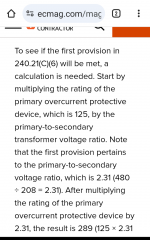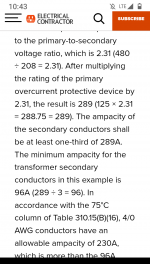Strathead
Senior Member
- Location
- Ocala, Florida, USA
- Occupation
- Electrician/Estimator/Project Manager/Superintendent
I am sure I am going to feel really stupid when someone explains the simple explanation of this question:
So, 240.21 (C)(6) says:
Where the length of secondary conductor does not exceed
7.5 m (25 ft) and complies with all of the following:
(1) The secondary conductors shall have an ampacity that is
not less than the value of the primary-to-secondary volt‐
age ratio multiplied by one-third of the rating of the over‐
current device protecting the primary of the transformer.
(2) The secondary conductors terminate in a single circuit
breaker or set of fuses that limit the load current to not
more than the conductor ampacity that is permitted by
310.15.
(3) The secondary conductors are protected from physical
damage by being enclosed in an approved raceway or by
other approved means.
I can't understand what they mean by (1) above. I believe the transformer voltage ratio would be 480 to 120 or 4-1 or 4(not to 208 correct?) But I don't see what that has to do with the next part. Say I have a 30 KVA 480 delta to 208/120 Wye transformer with a primary circuit breaker of 40A. 1/3 of that is 13.333 times 4 is 53 amps. So my SECONDARY conductors must have an ampacity of at least 53 amps. Is that all this is saying? That makes no sense to me. What am I missing?
So, 240.21 (C)(6) says:
Where the length of secondary conductor does not exceed
7.5 m (25 ft) and complies with all of the following:
(1) The secondary conductors shall have an ampacity that is
not less than the value of the primary-to-secondary volt‐
age ratio multiplied by one-third of the rating of the over‐
current device protecting the primary of the transformer.
(2) The secondary conductors terminate in a single circuit
breaker or set of fuses that limit the load current to not
more than the conductor ampacity that is permitted by
310.15.
(3) The secondary conductors are protected from physical
damage by being enclosed in an approved raceway or by
other approved means.
I can't understand what they mean by (1) above. I believe the transformer voltage ratio would be 480 to 120 or 4-1 or 4(not to 208 correct?) But I don't see what that has to do with the next part. Say I have a 30 KVA 480 delta to 208/120 Wye transformer with a primary circuit breaker of 40A. 1/3 of that is 13.333 times 4 is 53 amps. So my SECONDARY conductors must have an ampacity of at least 53 amps. Is that all this is saying? That makes no sense to me. What am I missing?



